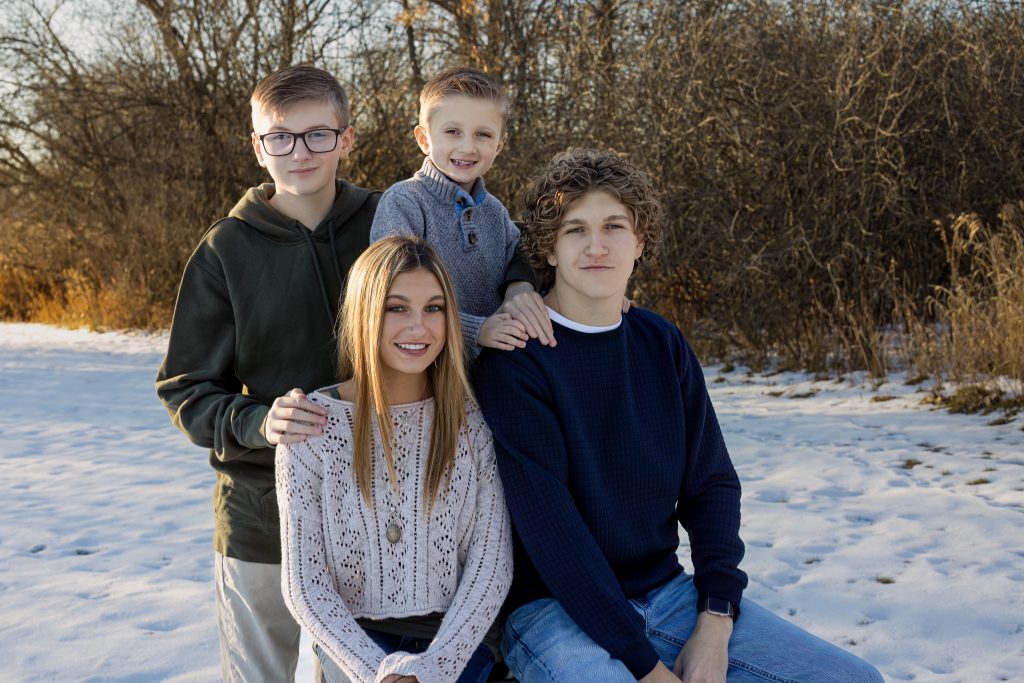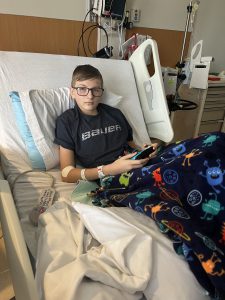Justin and his wife, Kris, Jahnz live in Pine City, Minnesota, with their four kids. They are an active family who always look at the glass as half full rather than half empty. This is an important quality to have as four out of the six members of their family have a blood clotting disorder called protein S deficiency. Staying positive has been a huge part of how they’ve moved forward as a family.
The journey to the diagnosis
Around 10 years ago, Justin had a significant blood clot. It was a scary time for their family as they had not experienced anything like this before. Justin received care for his clot and went on his way.

Then in 2021, his daughter and eldest child Grace (now 20 years old) developed a deep vein thrombosis (DVT) and a small pulmonary embolism (PE), collectively known as venous thromboembolism (VTE). This means that her blood clot that developed deep in her vein traveled to her lungs, which can be extremely dangerous and cause significant side effects, even death.
Because of Justin’s previous knowledge of his own blood clot, he knew some of the signs and symptoms to look for. He knew this was urgent and immediately took Grace to Children’s Minnesota, an hour drive from their home in Pine City.
At this point, they felt that since Justin and Grace both had blood clots that it might be hereditary, meaning this diagnosis might run in their family. So, the Jahnz family worked with both our hematology and genomic medicine program at Children’s Minnesota to get genetic testing done.
Through this testing they found out that not only did Justin and Grace have something called protein S deficiency, so did two of the other Jahnz children too – Elijah, age 14, and Samuel, age 7. “We were thankful to know what we were dealing with at this point,” Justin said.
Upon figuring out their diagnoses, Grace, Elijah, Samuel, and their family worked with the Center for Bleeding and Clotting Disorders thrombosis team at Children’s Minnesota for education, monitoring, and treatment.
“Children’s Minnesota is amazing, compassionate, professional, and their care is outstanding,” Justin said. “We are so thankful to have a resource so close to home.”

Thrombosis and what it means for their futures
Protein S deficiency is a disorder where your blood clots too much. For example, you got a cut on your finger. Your body typically has a protein that will help your blood clot to stop the bleeding, and then your body’s protein S will tell it that it no longer needs to clot the blood once the cut starts healing. For people with protein S deficiency, your body doesn’t know when to stop clotting.
Most people with this disorder and who have history of VTE will need to take blood thinners or anticoagulation to help stop your body from clotting too much. Justin and his two kids, Grace and Elijah, are all on blood thinners, and the family is aware that Samuel may need this treatment too.
Because they have an underlying clotting disorder and have to take blood thinners, the family members with this disorder need to be careful with how they live their lives. However, Justin and Kris remind their kids that: Although they have to be careful, they can still live their lives to the fullest, no matter what they’re fighting.
A change in lifestyle for the kids
Elijah

Elijah loved to play hockey when he was younger, but now that he has experienced a blood clot and is on blood thinners, contact sports are something he can no longer safely play. “We are looking forward to new opportunities other than hockey,” Justin said. “He can still enjoy life to the fullest, he just has to be cautious and aware of the risks.”
Grace
As for Grace, no one would know she has to take daily medication for this disorder from the outside. “She lives a full life. She is going to school to be an elementary school teacher,” said Justin. “She’s responsible and takes her medications every day, which is a huge component of treatment. She is living a good life.”
Those who menstruate and are on blood thinning medications need to be extra careful due to the increased risk of heavy menstrual bleeding. Blood thinning medications can cause increased blood loss during monthly periods, which can then lead to the risk of anemia (low blood levels) and iron deficiency. Contrastingly, certain menstrual management options place women at increased risks of blood clots, which could be detrimental in someone with an underlying clotting disorder. All of these things can be discussed with and treated by the care teams at Children’s Minnesota.
Today, Grace and Elijah get annual checkups with their hematologist at Children’s Minnesota. As a patient, knowing what to expect and how to treat their diagnosis is helpful.
Advice for families
Their diagnosis changed a lot for their family of six, but they aren’t letting it stop them. Justin and his wife are dedicated parents who believe in educating those around them about blood clots, and sharing the signs and symptoms so people know what to look out for in their own families.
One opportunity Justin uses to share awareness around education about blood clots and their disorder is through his compression socks. “Because of the damage caused by my clot, I need to wear compression socks to keep the blood flow back to my heart normal,” said Justin. “The socks often invite questions, and those questions are an opportunity to educate people on blood clots and the risks and associated symptoms.”

Through spreading awareness and education, the Jahnz family has helped many other families learn the signs and symptoms of blood clots – and the awareness of protein S deficiency. They’re thankful for the expert care from their Children’s Minnesota team. “I have a lot of confidence that we have access to the best minds to get the best care for our kids,” Justin said